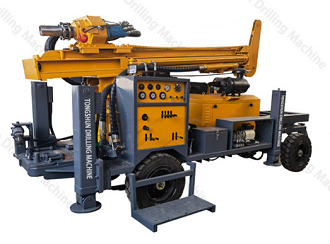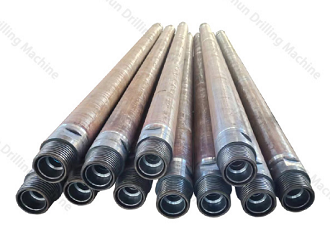Down-the-hole (DTH) drilling and top hammer drilling are two common methods used in the mining, quarrying, and construction industries for drilling holes in rocks and other hard materials. The main difference between them lies in the position of the drilling mechanism and the type of drill pipe used.
1. Down-the-Hole Drill Pipe: Down-the-hole drilling, also known as DTH drilling, involves a drilling mechanism located at the bottom of the drill string. The drill bit is placed at the end of the drill pipe, and a percussion hammer mounted above it delivers powerful blows directly to the bit. The drill bit rotates while simultaneously hammering into the rock, creating a hole.
DTH drill pipes are generally heavier and longer compared to top hammer drill pipes. They are designed to withstand the high impact forces generated by the percussion hammer and the weight of the drill string. DTH drilling is commonly used for larger diameter holes, typically starting from 3 inches (76 mm) and above.
2. Top Hammer Drill Pipe: Top hammer drilling, also known as drifters or rock drills, involves a drilling mechanism located above the drill bit. In this method, a pneumatic or hydraulic-powered hammer is positioned at the top of the drill string, and the percussion force is transmitted down to the bit through the drill pipe. The drill bit rotates while the hammer strikes the top of the bit, producing the drilling action.
Top hammer drill pipes are generally shorter and lighter compared to DTH drill pipes. They are designed for smaller diameter holes, typically ranging from 0.4 inches (10 mm) to 6 inches (152 mm). Top hammer drilling is commonly used for tasks like blast hole drilling, bench drilling, and underground drilling.
In summary, the main difference between down-the-hole drill pipes and top hammer drill pipes lies in the position of the drilling mechanism and the type of drilling action they perform. DTH drilling utilizes a drilling mechanism at the bottom of the drill string and delivers powerful blows directly to the bit, while top hammer drilling has the mechanism above the drill bit and transmits the percussion force down to the bit. The choice between these methods depends on the required hole diameter, drilling conditions, and specific application requirements.
Down-the-Hole (DTH) drilling is renowned for its outstanding penetration rates and efficiency, making it an ideal choice for deep-hole drilling. The DTH technique involves a pneumatic hammer that drives a drill bit into the rock with percussive action, chipping away at the formation. Key advantages of DTH drilling include:
1. Deep Drilling Capability: DTH drilling is particularly effective for deep-hole applications, allowing for precise and reliable drilling at significant depths.
2. Low Deviation: The straightness and accuracy of DTH drilling ensure minimal deviation, making it suitable for projects where precision is critical.
3. Versatility: DTH drilling can handle various rock types, ranging from soft to extremely hard formations, making it a versatile option for diverse geological conditions.
4. Reduced Hole Deviation: The guidance provided by the drilling rod directly attached to the bit minimizes hole deviation during the drilling process.
Top Hammer drilling utilizes a percussive mechanism mounted on the top of the drill string, making it highly efficient for surface drilling and smaller-scale projects. Key advantages of Top Hammer drilling include:
1. Speed and Efficiency: Top Hammer drilling excels in surface drilling applications, offering higher drilling speeds and efficiency for shallower holes.
2. Lower Equipment Cost: Compared to DTH drilling, Top Hammer equipment generally has lower initial costs, making it attractive for projects with budget constraints.
3. Ideal for Cohesive Formations: Top Hammer drilling is particularly effective in cohesive rock formations, providing reliable performance in such geological conditions.
4. Ease of Maintenance: The top-mounted design of the hammer simplifies maintenance and reduces downtime, contributing to increased productivity.
While both DTH and Top Hammer drilling techniques have their strengths, selecting the appropriate method depends on various factors, including:
1. Drilling Depth: For deep-hole drilling projects requiring straightness and precision, DTH drilling emerges as the superior choice.
2.Geological Conditions: The hardness and composition of the rock formation significantly impact drilling performance. DTH drilling's adaptability to varying rock types makes it a versatile option, while Top Hammer excels in cohesive formations.
3. Project Scale: Smaller-scale surface drilling projects often benefit from the speed and cost-effectiveness of Top Hammer drilling.
4. Budget and Investment: Companies must consider their budgetary constraints and long-term investment plans when deciding between DTH and Top Hammer drilling equipment.
Both DTH drilling and Top Hammer drilling play distinct roles in the realm of rock drilling. DTH's efficiency in deep-hole drilling and adaptability to diverse geological conditions make it the preferred choice for demanding projects. On the other hand, Top Hammer drilling's speed, cost-effectiveness, and effectiveness in cohesive formations render it suitable for specific surface drilling applications. By comprehending the nuances of these techniques and thoroughly assessing project needs, drilling professionals can make informed decisions to enhance performance and attain outstanding results in their rock drilling endeavors.


Copyright © Jinzhou City TongShun Drilling Machine Co.,Ltd. All Rights Reserved Sitemap | Powered by 